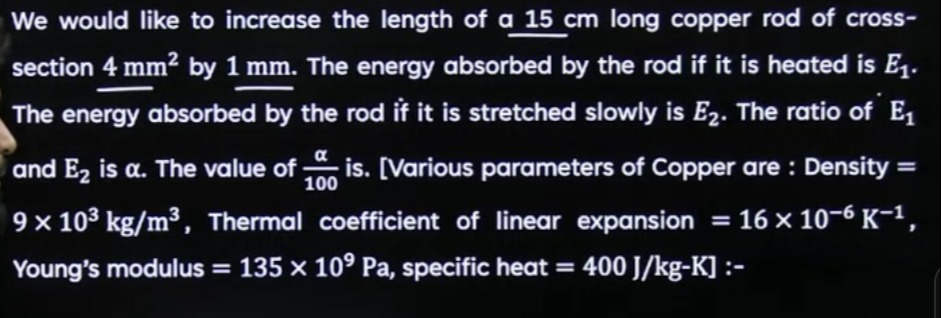Question
Question: We would like to increase the length of a 15 cm long copper rod of cross-section 4 mm² by 1 mm. The ...
We would like to increase the length of a 15 cm long copper rod of cross-section 4 mm² by 1 mm. The energy absorbed by the rod if it is heated is E₁. The energy absorbed by the rod if it is stretched slowly is E₂. The ratio of E₁ and E₂ is α. The value of 100α is. [Various parameters of Copper are : Density = 9 × 10³ kg/m³, Thermal coefficient of linear expansion = 16 × 10⁻⁶ K⁻¹, Young's modulus = 135 × 10⁹ Pa, specific heat = 400 J/kg-K] :-

5
Solution
Solution:
-
Heating:
ΔT=LαthΔL.
The temperature rise needed for a linear expansion ΔL is given byThe mass of the rod is
m=ρAL.Thus, the energy absorbed by heating is
E1=mcΔT=ρALc(LαthΔL)=αthρAcΔL. -
Stretching:
E2=21YALΔL2.
The elastic energy stored when a rod is stretched by ΔL is -
Ratio:
α=E2E1=21YALΔL2αthρAcΔL=YαthΔL2ρcL.
The ratio is -
Substitute given values:
ρ=9×103kg/m3,c=400J/kg-K,L=15cm=0.15m, ΔL=1mm=0.001m,αth=16×10−6K−1,Y=135×109Pa.Now,
α=135×109×16×10−6×0.0012×9×103×400×0.15.Calculating numerator:
2×9×103=18×103, 18×103×400=7.2×106, 7.2×106×0.15=1.08×106.Calculating denominator:
135×109×16×10−6=2160×103=2.16×106, 2.16×106×0.001=2160.Thus,
α=21601.08×106=500.The required value is
100α=100500=5.
Core Explanation:
-
For heating, energy E₁ = (ρAc ΔL) / (αₜₕ).
-
For stretching, energy E₂ = (1/2)YA(ΔL²/L).
-
Ratio α = (2ρcL)/(YαₜₕΔL).
-
Substitute values to get α = 500; hence, (α/100) = 5.
